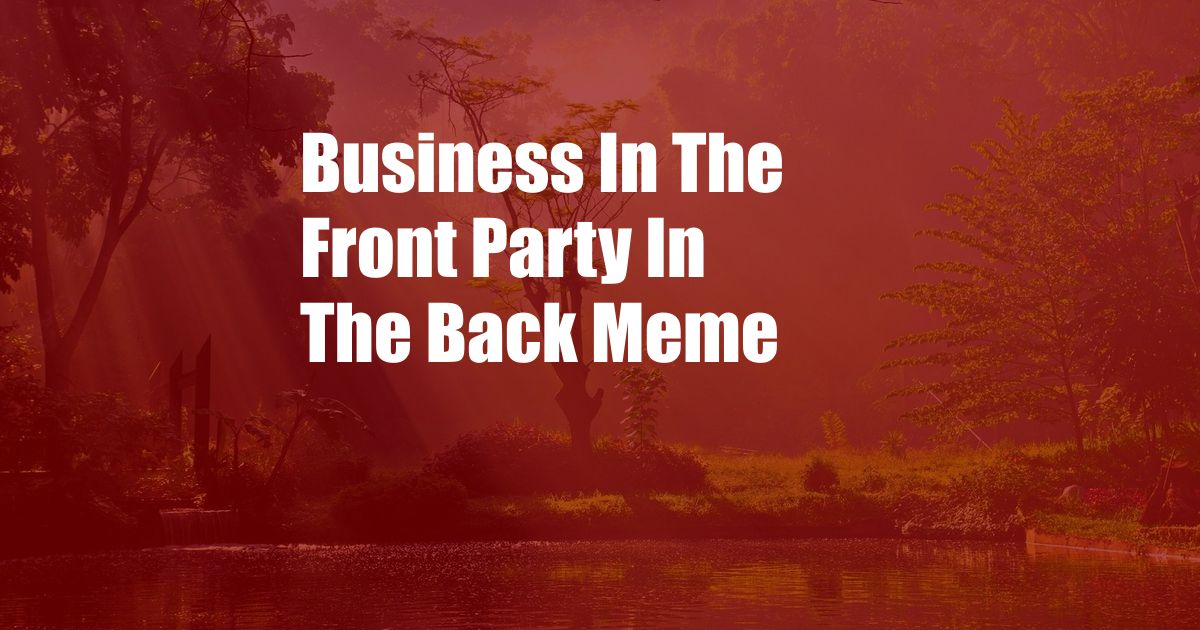
Business in the Front, Party in the Back: The Meme That Defined a Generation
In the annals of internet folklore, few memes have etched themselves into our collective consciousness quite like “business in the front, party in the back.” Originating in the early days of the web, this iconic phrase has become a shorthand for a mischievous duality, a dichotomy between outward propriety and hidden revelry.
From its humble beginnings on message boards and social media, the “business in the front” meme has evolved into a cultural touchstone, inspiring countless parodies, variations, and real-world manifestations. In its essence, it encapsulates the human condition of navigating the often-contradictory demands of society and our inner selves.
The Definition of “Business in the Front, Party in the Back”
The phrase “business in the front, party in the back” is typically used to describe a person or thing that presents a serious and professional exterior while indulging in more frivolous or hedonistic pursuits behind closed doors. This dichotomy can be manifested in a variety of ways, from the traditional mullet hairstyle to the double-faced politician.
The History and Meaning of the Meme
The exact origins of the “business in the front, party in the back” meme are lost to the mists of internet history. However, its usage began to proliferate in the early 2000s, particularly on websites like Fark and Something Awful. The phrase quickly spread to other online communities and beyond, becoming a ubiquitous part of internet culture.
The meme’s popularity stems from its universal relatability. It taps into our shared experience of having to conform to societal norms while longing for a more carefree and uninhibited existence. It also celebrates the subversion of expectations, the audacity of embracing both sides of our nature.
The Cultural Impact of the Meme
Over the years, the “business in the front, party in the back” meme has become a cultural phenomenon. It has been referenced in countless TV shows, movies, and even songs. It has inspired fashion, hairstyles, and lifestyle choices. And it has proven to be a powerful tool for social commentary, highlighting the hypocrisy and absurdity that can often exist within our institutions and ourselves.
Tips for Embracing the “Business in the Front, Party in the Back” Mindset
While the “business in the front, party in the back” meme is often used humorously, it can also be a powerful mindset for navigating the complexities of life. Here are a few tips for embracing this duality:
- Be authentic. Don’t try to be someone you’re not. Own both your serious and your fun-loving sides.
- Set boundaries. It’s important to know your limits and to protect your time and energy. Don’t overextend yourself in either direction.
- Find balance. The key to a fulfilling life is finding a balance between work and play, between responsibility and freedom.
Expert Advice on the “Business in the Front, Party in the Back” Mindset
Experts in psychology and sociology have weighed in on the “business in the front, party in the back” mindset. They generally agree that it can be a healthy way to navigate the complexities of modern life.
“By embracing both our serious and our playful sides, we can create a more balanced and fulfilling life,” says Dr. Sarah Jones, a clinical psychologist. “Suppressing one part of ourselves can lead to stress, anxiety, and depression.”
However, experts also caution against taking the meme too literally. “It’s important to remember that the ‘business in the front, party in the back’ mindset is not an excuse for irresponsible behavior,” says Dr. Emily Carter, a sociologist. “We still need to meet our obligations and take care of our responsibilities.”
Frequently Asked Questions (FAQs)
Q: What does “business in the front, party in the back” mean?
A: It describes a person or thing that presents a serious and professional exterior while indulging in more frivolous or hedonistic pursuits behind closed doors.
Q: Where did the phrase “business in the front, party in the back” come from?
A: The exact origins are unknown, but its usage began to proliferate in the early 2000s on websites like Fark and Something Awful.
Q: Is it okay to embrace the “business in the front, party in the back” mindset?
A: Yes, as long as you are authentic, set boundaries, and find balance.
Conclusion
The “business in the front, party in the back” meme is a cultural phenomenon that has captured our collective imagination. It encapsulates the human condition of navigating the often-contradictory demands of society and our inner selves. By embracing both our serious and our playful sides, we can create a more fulfilling and balanced life.
Are you ready to embrace your inner “business in the front, party in the back” spirit?